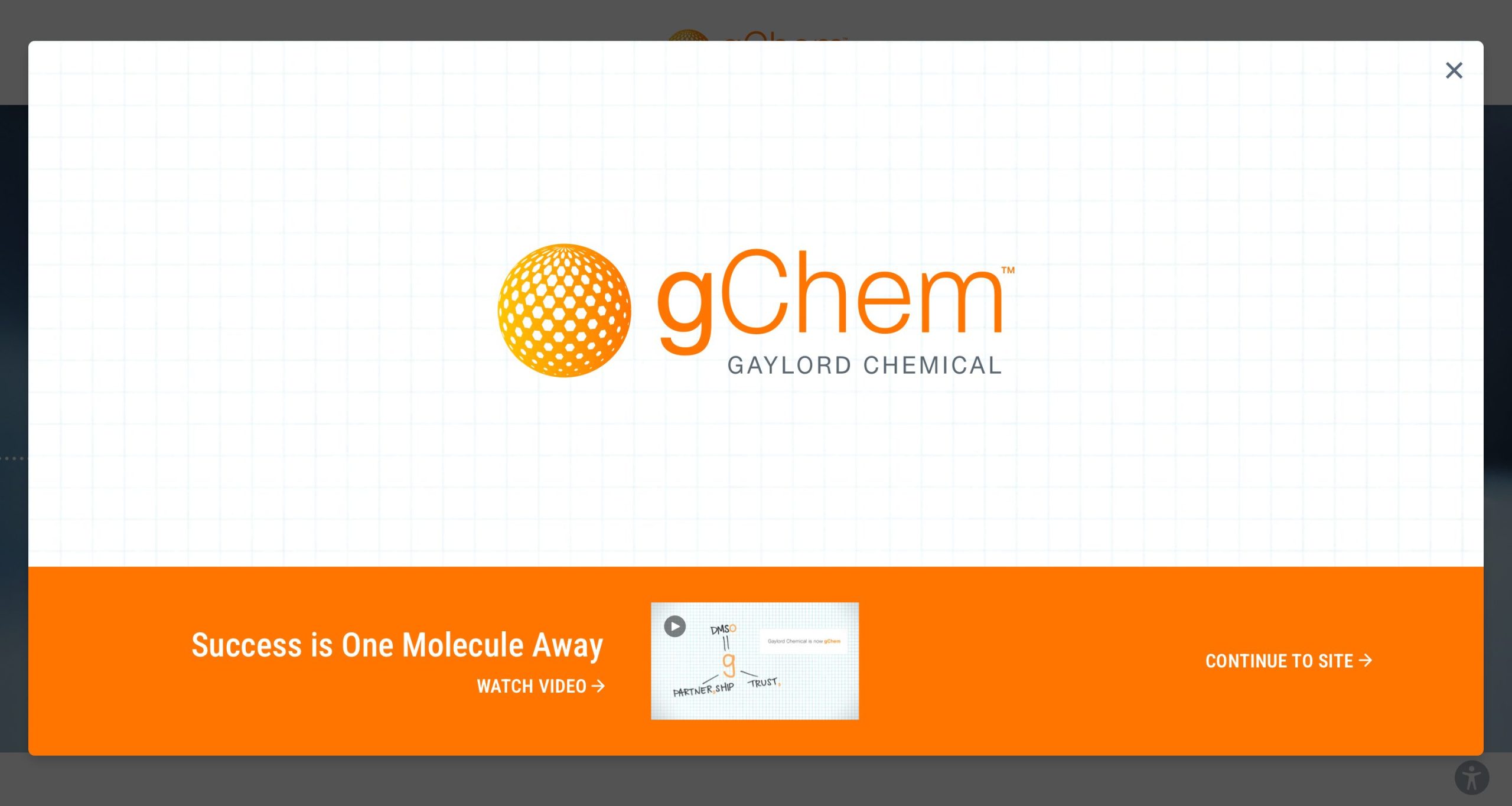Introduction
Dimethyl Sulfoxide (DMSO), one of the strongest organic solvents, has been used commercially for several decades. It is an effective solvent for a wide array of organic materials, including many polymers. DMSO also dissolves many inorganic salts, particularly transition metals nitrates, cyanides and dichromates. DMSO is miscible with water and most organic liquids.
Contact Gaylord Chemical Request A Sample
The contents of this page summarize solubility characteristics for DMSO.
Contents
1. Organics
2. Active Pharmaceutical Ingredients
3. Resins and Polymers
4. Inorganics
5. Gases
6. Pharmaceutical Excipient Solubility Data
7. DMSO Gel Preparation Data
Data related to the solvent properties of DMSO are given in tables on the following pages:
8. Relative Hansen Solubility Parameter Data
9. Suggested DMSO Formulations for Industrial Solvent Replacement
10. Hansen Solubility Parameter Data for Selected Polymers
11. Solubility of Selected Polymers in DMSO / Tetralin mixtures
12. Solubility of Selected Polymers in DMSO / MIBK mixtures
Table 1
Solubility of Organic Materials in DMSO
Table 2
Solubility of Active Pharmaceutical Ingredients in DMSO
Table 3
Solubility of Resins and Polymers in DMSO
Table 4
Solubility of Inorganic Materials in DMSO
Table 5
Solubility of Gases in DMSO (@Atmospheric Pressure, 20°C)
Table 6
Relative Hansen Solubility Parameter Data
Table 7
Solubility of DMSO Formulations for Industrial Solvent
Table 8
Hansen Solubility Parameter data for Selected Polymers
Tables 9 and 10 illustrate how the solvency of a mixture for selected polymers can be related to the composition of the mixture. Predicted solvencies of mixtures of DMSO and tetralin or DMSO and methyl isobutyl ketone for these eight polymers are tabulated. A solvency value of 100 was assigned to mixtures at the center of the HSP envelope and a value of 0 to mixtures at the envelope boundary. These tables also show how solvency changes with the composition of the mixture, with ratio of the solvents selected, and show the composition of maximum solvency for each polymer and solvent pair.
Table 9
Solubility of Selected Polymers in DMSO/Tetralin Mixtures
Table 10
Solubility of Selected Polymers in DMSO/MIBK Mixtures
Table 11
Pharmaceutical Excipient Solubility Data
DMSO Gel Preparation Data
Pharmaceutically acceptable gelling agents suitable for the formulation of topical / transdermal DMSO products were evaluated to understand the effect of polymer loading on formulation viscosity. METHOCEL™ is a trademark of the Dow Chemical Company.
All viscosity measurements were recorded using a Brookfield Model DV-E Digital Viscometer, using spindle 61 at 100 rpm. Gels were measured at 73°F (23°C). The diameter of the measurement vessel was 8 cm.
Methocel A4M: All viscosity measurements were recorded using a Brookfield Model DV-E Digital Viscometer using spindle 61 for measurements at 0.5, 1.0 and 1.5 % polymer. Spindle 63 was used for the 2.0 % sample. Instrument settings of 100, 30, 6 and 100 RPM were used for samples containing 0.5, 1.0, 1.5, and 2.0 wt% polymer, respectively. Gels were measured at 73°F (23°C). The diameter of the measurement vessel was 8 cm.
Methocel E4M: All viscosity measurements were recorded using a Brookfield Model DV-E Digital Viscometer, using spindle 61. Instrument settings of 100, 30, 12 and 5 RPM were used for samples containing 0.5, 1.0, 1.5, and 2.0 wt% polymer, respectively. Gels were measured at 73°F (23°C). The diameter of the measurement vessel was 8 cm. Formulation included 1.0 wt% triethanolamine.
Other Dow rheology modifiers currently under evaluation include: Polyox® WSR N10 NF, Methocel E5 LV, Ethocel® Standard 4 NF and Ethocel Standard 10
Pharmaceutically acceptable gelling agents suitable for the formulation of topical / transdermal DMSO products were evaluated to understand the effect of polymer loading on formulation viscosity. Klucel® is a trademark of Ashland. Carbopol® is a trademark of Lubrizol.
Klucel HF: All viscosity measurements were recorded using a Brookfield Model DV-E Digital Viscometer, using spindle 61 for measurements at 0.5, 1.0 and 1.5 % polymer. Spindle 64 was used for the 2.0 % sample. Instrument settings of 60, 2.5, 0.6 and 20 RPM were used for samples containing 0.5, 1.0, 1.5, and 2.0 wt% polymer, respectively. Gels were measured at 73°F (23°C). The diameter of the measurement vessel was 8 cm
Other Ashland rheology modifiers currently under evaluation include: Klucel™ GF, HFX, LF, MF, EF, JF.
Carbopol 941 NF : All viscosity measurements were recorded using a Brookfield Model DV-E Digital Viscometer. using spindle 64 for measurements at 1.5 % and 2.0% polymer. Spindle 61 was used for the 0.5 % sample and spindle 62 for the 1.0% sample. Instrument settings of 30, 1.0, 100 and 0.3 RPM were used for samples containing 0.5, 1.0, 1.5, and 2.0 wt% polymer, respectively. Gels were measured at 73°F (23°C). The diameter of the measurement vessel was 8 cm.
Other Noveon rheology modifiers currently under evaluation include: Carbopol 940 NF, 934 NF, 980 NF, 934 NF, 981 NF, 1342 NF, 71G NF, 974 NF, Ultrez 10 NF, 971P NF
General procedure for preparing DMSO-based gel products. DMSO-based gels are prepared using methods similar to those described by manufacturers for water-based media. The additive is sifted with stirring into DMSO and allowed to disperse over 30-60 minutes. Warming the mixture at 50°C is helpful in dispersing the additive, and pH adjustment using suitable bases is often useful. In the case that less polar cosolvents are included, it may be best to form a pregel in DMSO, followed by slow addition of the less polar cosolvent. Recommended packaging materials for storage include HDPE, HDPP, or Teflon® PTFE.
The information in this bulletin is based on information available to us and on our observations and experiences. However, no warranty is expressed or implied regarding the accuracy of this data, the results to be obtained from the use thereof, or that any use will not infringe any patent. Each user must establish appropriate procedures for off-loading, handling, and use of the product(s). Since conditions for use are beyond our control, we will make no guarantee of results, and assume no liability for damages incurred by off-loading, handling, or use of the product(s). Nothing herein constitutes permission, or recommendation to practice any invention covered by any patent without license from the owner of the patent.







